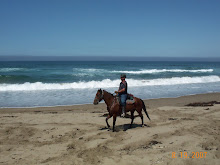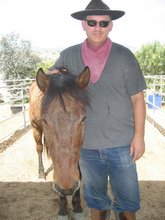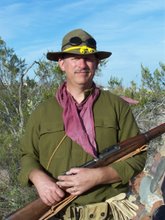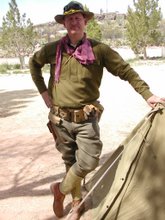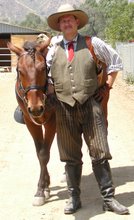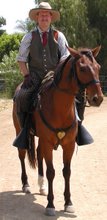Check out this interesting video of the present-day Chilean cavalry on YouTube:
Except for the modern planes and cars and some smaller details, this could easily pass for Germany c. 1918. The cavalry march itself is German, along with the styling of the uniforms, equipment and horse furniture/tack. Way cool!
I especially love the collected canter- yeah!!!
Saturday, April 24, 2010
Monday, April 12, 2010
Max & I Doing Civil War at Prado
 Last weekend, I participated in a Civil War reenactment with my horse Max. I’ve been involved in Civil War reenacting for some 20 years but this was the first time as mounted cavalry. I arrived at Prado with Max late Friday afternoon and we had ample time to get Max situated with ample supplies of water and alfalfa. The group I belong to had already set up a picket line (aka high line) and I picked a place to tie him up that wasn’t too close to another horse so as to avoid injuries from fighting or play. It’s essential when taking a horse away from their normal environment to make sure that they have enough water and forage to eat, preferably the forage that they normally eat at home. Some horses also don’t like to drink the water in a strange location so I brought water from home but ultimately didn’t need it.
Last weekend, I participated in a Civil War reenactment with my horse Max. I’ve been involved in Civil War reenacting for some 20 years but this was the first time as mounted cavalry. I arrived at Prado with Max late Friday afternoon and we had ample time to get Max situated with ample supplies of water and alfalfa. The group I belong to had already set up a picket line (aka high line) and I picked a place to tie him up that wasn’t too close to another horse so as to avoid injuries from fighting or play. It’s essential when taking a horse away from their normal environment to make sure that they have enough water and forage to eat, preferably the forage that they normally eat at home. Some horses also don’t like to drink the water in a strange location so I brought water from home but ultimately didn’t need it.
Early the next morning, I assisted in mucking along the picket line and feeding and watering the horses. When in a group situation, it’s always advisable to feed and water all the horses at the same time so as to avoid fighting or disruptive behavior. Afterwards, I saddled and tacked up Max. While the first battle wasn’t until 1 PM, I wanted to work Max first and see how his attitude was. Because we portray Union cavalry (Company A, 10th Ohio Volunteer Cavalry), the standard issue saddle was the Model 1859 McClellan saddle and that is what we use but in reproduction form.
After saddling and tacking, I found an empty area and proceeded to work Max. I started, as I normally do, at the walk and using a number of exercises aimed at increasing Max’s flexion and stretching his muscles. In a typical reenactment, a horse is often called upon to bend, twist, move on the hind end and fore-end and be ready to trot or canter at a moment’s notice. It is highly recommended that any horse used in battle reenactments be in excellent physical condition and possess a high degree of flexion. After loosening up at the walk, I then proceeded to work at the trot and finally at the canter.
While working at all three gaits, I also combined various movements such as leg-yields, side-passes, spins on the haunches and fore-ends, and transitions between gaits (you can never have enough transitions). My horse was a bit on the lively side, no doubt due to the new venue and being around the other horses and while I managed to get Max calmed down a bit, I also knew that I was going to have to stay alert to Max’s actions. Finally, I worked Max along with the rest of the unit in various formations and for the most part he was good (although keeping him in line required some quick corrections).

Finally, it was time for the first battle and we proceeded to the battlefield site, along with the rest of the unit, in proper military formation. Two of the most commonly used formations are line and columns of twos or fours and these are the basic formations used in battle. Soon, the battle began and we found ourselves opposed by an equal amount of opposition (we were playing the part of Confederates for this battle). The horses in my formation soon picked up on the presence of other horses and you could feel their excitement. As we proceeded to maneuver, I found myself having to constantly tap Max with a spur to focus his attention on what I wanted- it was clear that his attention was not on me.
There are two basic forms of combat that we use: Pistol shooting and saber fighting. For pistols, we use reproduction single-shot cap and ball revolvers that fire black powder charges. Typically, we will ride forward single file and the formation will then circle away while each person fires in the direction of the enemy (we maintain a safety zone of about 50 feet) and we’ll repeat this until our pistols are emptied. Afterwards, we would regroup in formation and await the next command. Often, we’ll then be given the order to draw saber and charge the enemy.
For saber fighting, each person will pair themselves up with an opponent and proceed to clash the saber blades. Making slashing movements against either the opposing horse or man is prohibited so typically a fight will consist of each person pushing their saber blade against their opponent’s saber blade. At the same time, each man will be moving their horse in a circular fashion and attempt to gain an advantage by getting around their opponent’s blade. Once this is done, the disadvantaged opponent is considered to be wounded or killed and they will withdraw from the engagement. Often, opponents will pass each other at either walk or trot, and strike their blades before moving off and finding another opponent. There are no hard and fast rules for “victory” and the end result is often determined by the scenario.
Most of the fighting is usually between opposing cavalry, although occasionally the cavalry will ride up and shoot at infantry. With any shooting, care is taken to ensure that the minimum safety distance is maintained and nobody directly fires at another person. Also, when cavalry fights, combats are to involve only one type of weapon (either pistol-on-pistol or saber-on-saber). The preceding description is just a basic overview and there can be all manner of variations on how the forces fight. However, the one thing that’s constant is that safety always comes first; especially since people can get unhorsed quite easily (it happened twice during the weekend). The battles themselves lasted about 30 minutes each and we did two per day. After each battle, the horses were rested and watered. Also, they were provided with a constant supply of forage.
Although doing mock battles on horseback can be fun (and exhausting), there are some things that the rider has to be prepared for. First, the rider needs to train extensively prior to attending their first event- the event itself is not the time to introduce a horse to reenacting and it’s a recipe for disaster, both for yourself and others around you. Ideally, the rider should have been working with a group for at least three or four months prior on a regular basis and getting their horse used to working in close proximity with other horses. When working as cavalry, horses will frequently bump and crash into each other and you don’t want your horse to react by striking out (the temperament of the individual horses also needs to be considered and some never make suitable cavalry mounts). Also, horses need to be desensitized to gunfire, cannon fire and being in close proximity to large numbers of people moving around them on foot in close proximity with weapons. Each horse to going to react differently and you have to be aware of your horse’s personality.
Some other essential things to remember in preparing for reenactments is that the rider needs to constantly train so as to develop a good seat- battles happen so quickly that the rider doesn’t have time to worry about where their body is positioned and they need to constantly remain in balance. Also, the rider’s seat needs to be independent of what the rest of their body is doing because there’s a lot of things that are going on at one time: handling weapons, looking out for other riders, listening for orders, looking out for ground hazards such as gopher holes, etc. Bottom line is that the rider doesn’t have time to think about your riding too much and it has to come naturally.
Finally, the rider has to be aware of the herd mentality and know how to deal with it: sometimes it can work to the rider’s advantage and at other times at a disadvantage. For moments like charging into battle or rallying, it can be helpful because the horse naturally wants to be with his buddies. At other times such as moving off alone from the unit or having the unit move away, the horse still wants to follow and you have to fight the horse’s instinct. Naturally, training can help reduce a lot of this problem but it’s always going to be there.
Overall, this was an excellent event and I learned a lot about working my horse in stressful situations. Also, my horse and I learned a lot about working together as a team and by the end of the weekend, I felt that Max was actually having fun (especially chasing the other horses) and that he was paying attention to my aids. I’d definitely recommend this for someone looking to do something different with their horse.
Subscribe to:
Posts (Atom)



